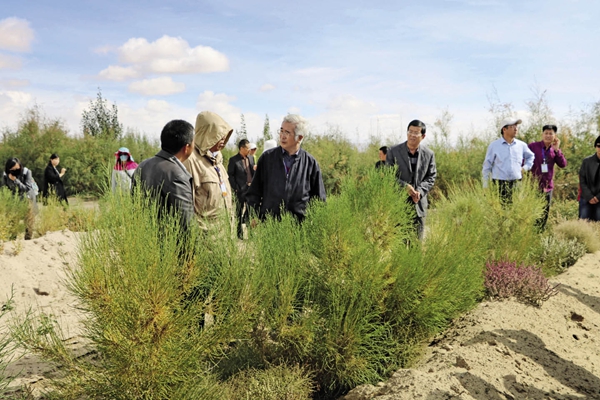Developing Eco-industry to Curb Desertification
China Today by Chen Xin, November 10, 2016 Adjust font size:

An Fengjie (third left), inspector with the Department of Rural Forestry Reform and Development, State Forestry Administration of China, inspects a cistanche planting base in Haixi. An is also director of China National Sand Control and Desert Industry Society.
Qaidam is located in the center of the Qinghai-Tibet Plateau that is claimed to be one of the world’s four super clean areas. Under a plateau continental climate, the basin is dry and enjoys strong sunlight, vast temperature variations between day and night, and abundant surface water and groundwater resources.
In addition, the arable land in the Qaidam Basin is gray-brown desert soil, a kind of sandy loam, which is the best soil for growing goji berries because it has the optimum pH value and contains components such as ammonia, phosphorus, potassium, and organic matter. These natural conditions are good for the formation of organic substances and effective constituents in the fruit.
One more credit is the cold, dry weather in Haixi that prevents the fruit from being overrun by pests and di-seases. The goji berry planting area is far away from the cities so the plants grow in an environment free of polluted water and soil, which ensures organic and healthy fruit.
Thanks to these climate and geographical conditions, the goji berries produced in Qaidam Basin are bigger and brighter in color, and have a higher nutritional value and effective constituents compared with those cultivated in other areas. In recent years, the CPC prefectural committee and the government of Haixi have been striving to develop green, ecological industries, the most successful of which have been the goji berry and cistanche grafted on sacsaoul.
Currently, the area of goji berry cultivation stands at 500,000 mu (15 mu=1 hectare), including 70,000 mu across two standardized organic planting bases, 30,000 mu of which meeting the organic standards of the European and the U.S. markets. Haixi Prefecture has formulated two local standards for goji berry planting, which guide the operation of over 30 production lines that produce up to 50 varieties of products.
A complete industrial chain has been formed in Haixi from planting, processing, technology research and development to sales. As China’s second largest goji berry producing area, Haixi is listed among the seventh group of national agricultural standardization demonstration areas. Its yearly output of goji berry reaches 60,000 tons, with a comprehensive value of RMB 6 billion. The average annual export volume floats between 800 and 900 tons, bringing about a revenue of US $10.79 million.
Haixi so far has over 1,400 companies, cooperatives, and contractors of different sizes, engaging in goji berry planting and processing. They involve 8,361 rural households, each of whom can earn more than RMB 6,000 every year in the sector. More than 70,000 workers in the planting bases realize a total of service income of over RMB 500 million by gathering goji berry fruits.
In addition, the Haixi prefectural government has also encouraged farmers to breed livestock in the goji berry forests. In 2015, there were 20,300 goats and 72,000 chickens roaming in Haixi’s goji berry woods and harvested Chinese goji honey totaled 140 tons. The area for planting cistanche also amounted to 10,000 mu in the prefecture.